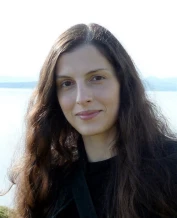March of the Sequels: Susana Imaginário
25 Mar 2023The Author/s

Susana Imaginário
Susana Imaginário is a misfit from Portugal. She moved to England to pursue a career as an aerialist and now runs a Tabletop Gaming retreat in Ireland with her husband.
Her hobbies include reading, playing board games, hanging upside down, poking around ancient ruins, talking to trees and being tired.Timelessness combines mythology with science fiction and slipstream fantasy in a strange and introspective way.
The Interview
First of all, tell me a little about your series and introduce us to the sequel(s).
Timelessness, in a nutshell, follows the journey of Psyche, the goddess of the soul, through Niflheim and the Underworld. It is set in a future where humans, as we know them, no longer exist, and the Universe is dominated by death and artificial life. The whole series is, in itself, a sort of sequel to some of the most famous Greek and Norse myths. Originally it was just one book, but because it was an impractically long book, I split it into four novels (Wyrd Gods, The Dharkan, Nephilim’s Hex, Anamnesis) and one novella (Anachrony). The whole thing was written with a reread in mind so you’ll only understand the beginning when you reach the end. ;)

Do you find that most of your readers continue to read the whole series? Why do you think that is?
No. Not most of my readers, unfortunately. Wyrd Gods is a strange and complex book. It has all the shortcomings of a debut novel and the disadvantages of being the first book in a series. The genre is closer to slipstream than fantasy and the storyline fragmented by design. Most people don’t get it and they lose interest. But those who do get it, love it. And most readers who finish the Dharkan will want to read the rest of the series.
How difficult is it to add new characters in a sequel into already established relationships?
Not difficult at all. For me, it’s much easier to introduce a new character into an already established relationship than to build it from scratch. I guess that’s why I borrowed so much from mythology.
Is it difficult to continue with worldbuilding for a world you have already built in book 1? Do you find it easier to switch locations for the sequel and start again with worldbuilding?
Everything in Timelessness circles back into itself. I have a limited number of locations that I reuse in different times, with different characters dealing with different situations. In a way, the locations are just like another character. They develop with the story.
Have you ever been stymied by a worldbuilding or plot detail from book 1 that is very inconvenient to deal with or write your way around in subsequent books?
Yes. I had to write an entire chapter in book 4 to explain my way around one sentence in book 1. It would be easier to just go back and delete that sentence or simply ignore it and hope no one noticed the plot hole. But figuring these things out is part of the joy of writing. I see it as an opportunity to be creative.
Would you say your craft has improved with the subsequent books?
Absolutely. Practice makes perfect, right? I had more time to revise and edit the sequels. Book 2, The Dharkan, is much better than Wyrd Gods. Book 3, Nephilim’s Hex is better than The Dharkan and Anamnesis, book 4, is the book I almost wish I’d written from the beginning. The more you write and revise what you write, the better you get at it. Besides, it’s easier to make sequels more engaging than the first book. You don’t need to spend so many words with backgrounds or worldbuilding. You can just focus on the actual story.
Do you have all the timeline planned for the full series?
I have an entire Universe planned. But I’ll try to publish only standalones from now on.
Do you have any marketing tips for sequels?
I’m hopeless at marketing…
My advice is to make each sequel better than the previous one. This way you’re less likely to disappoint those who took a chance on your work.
